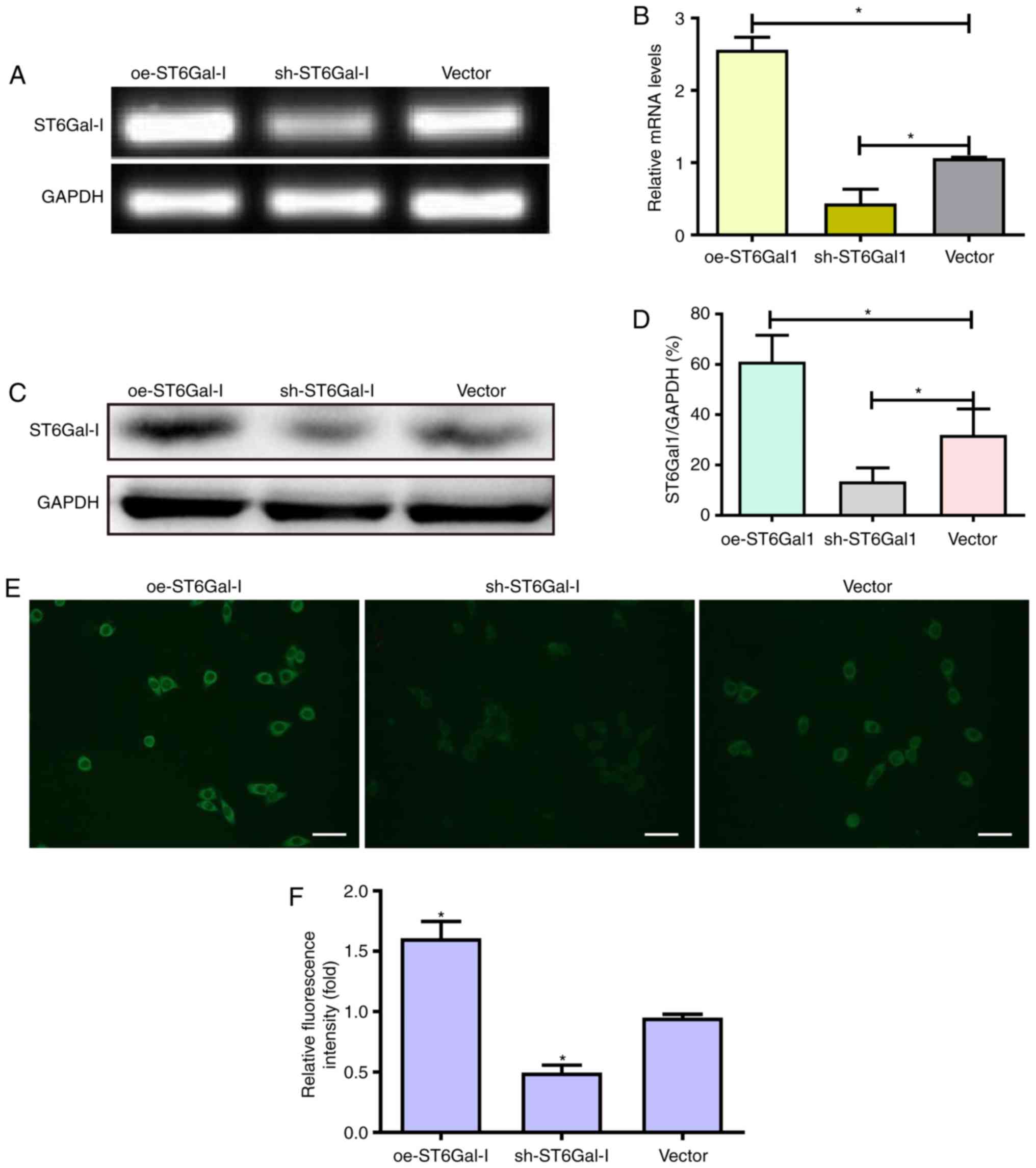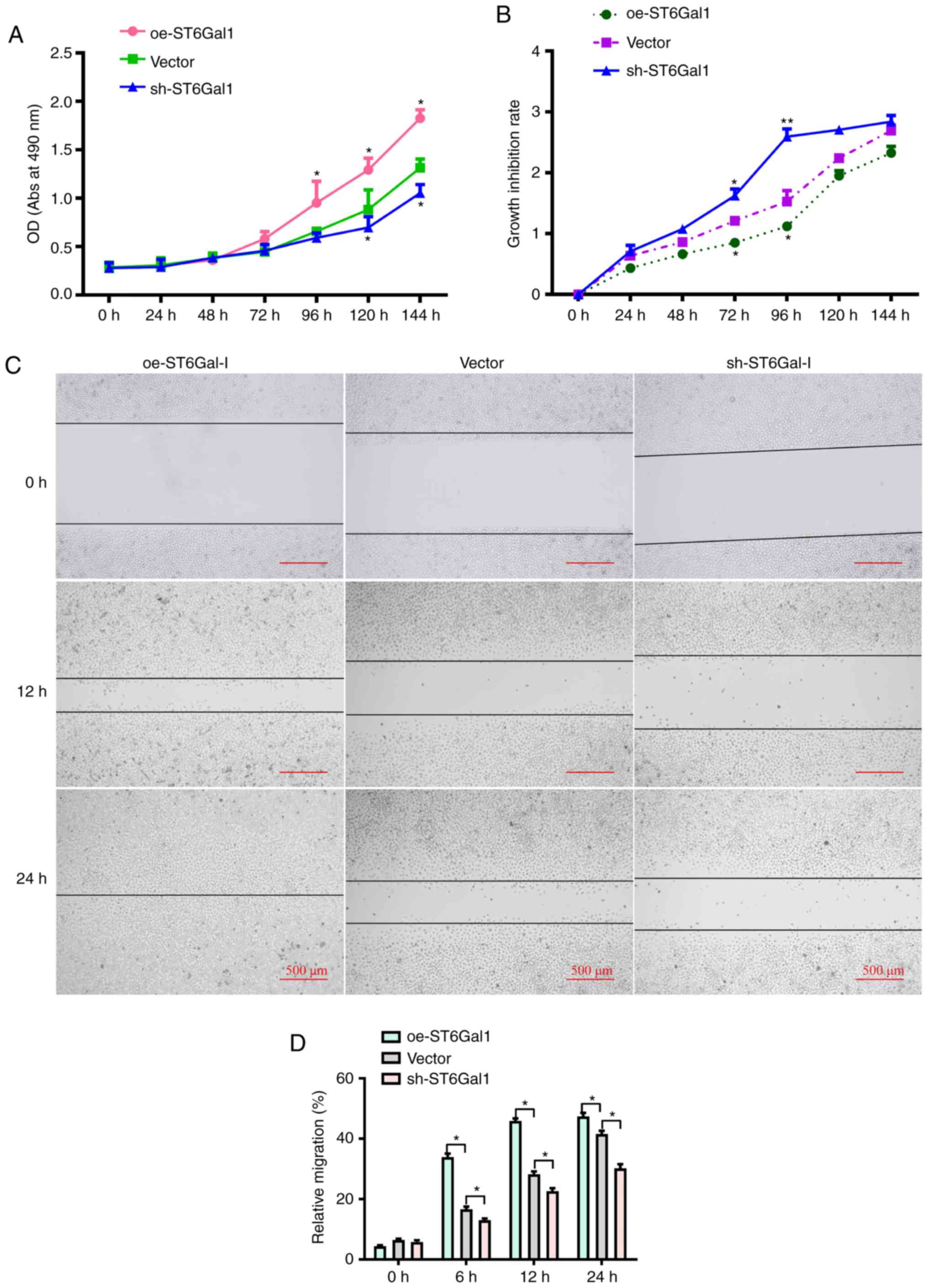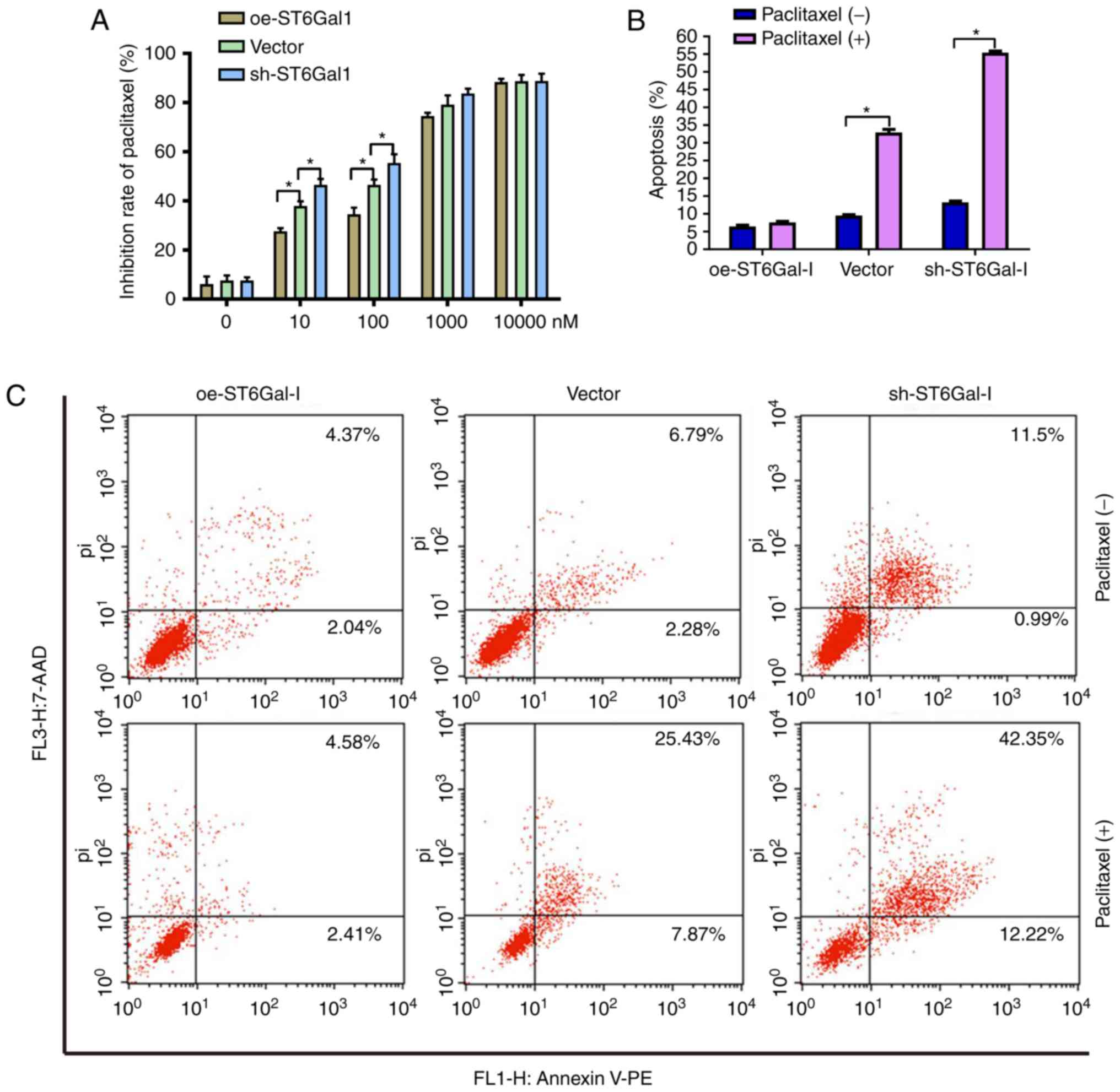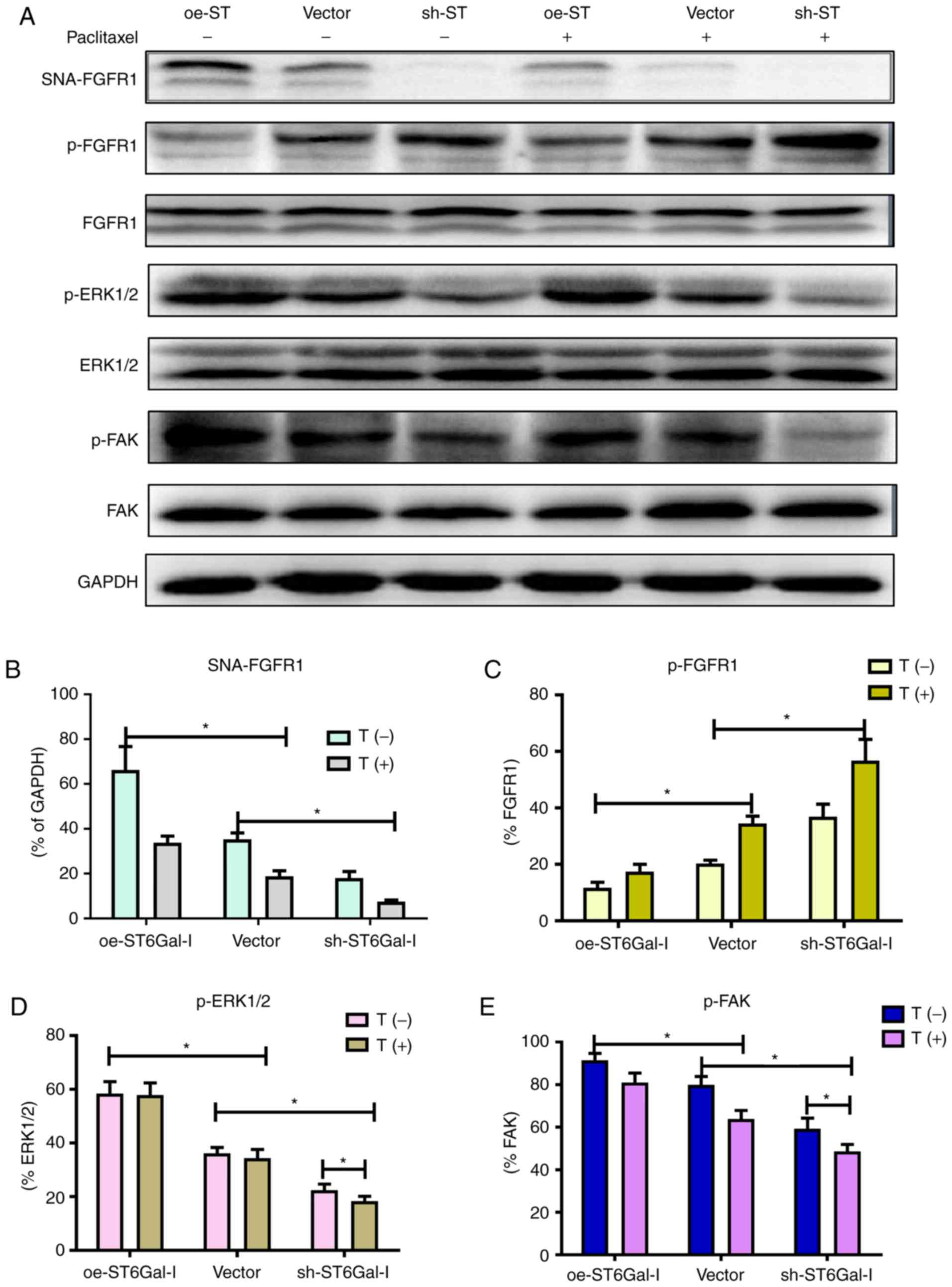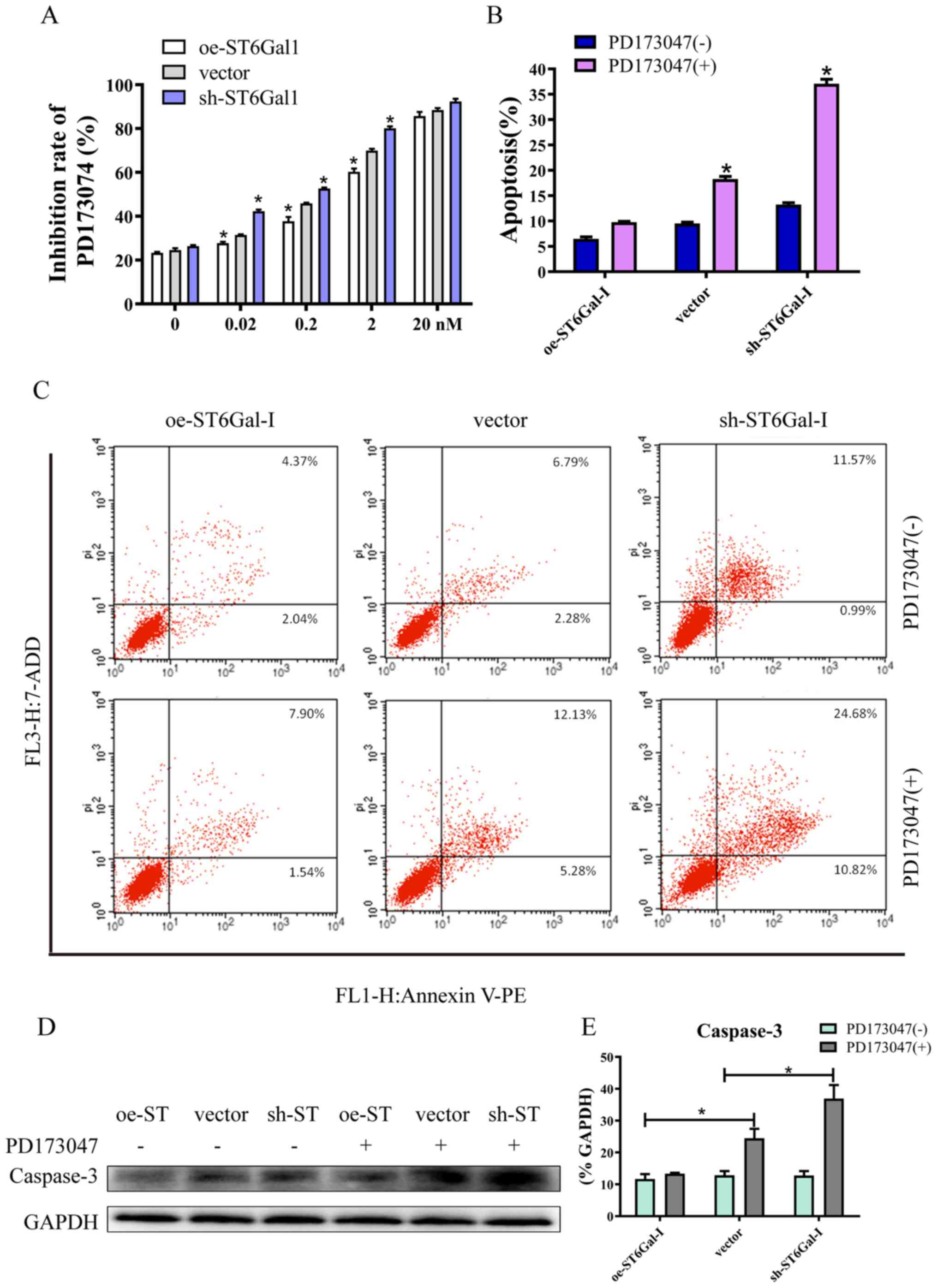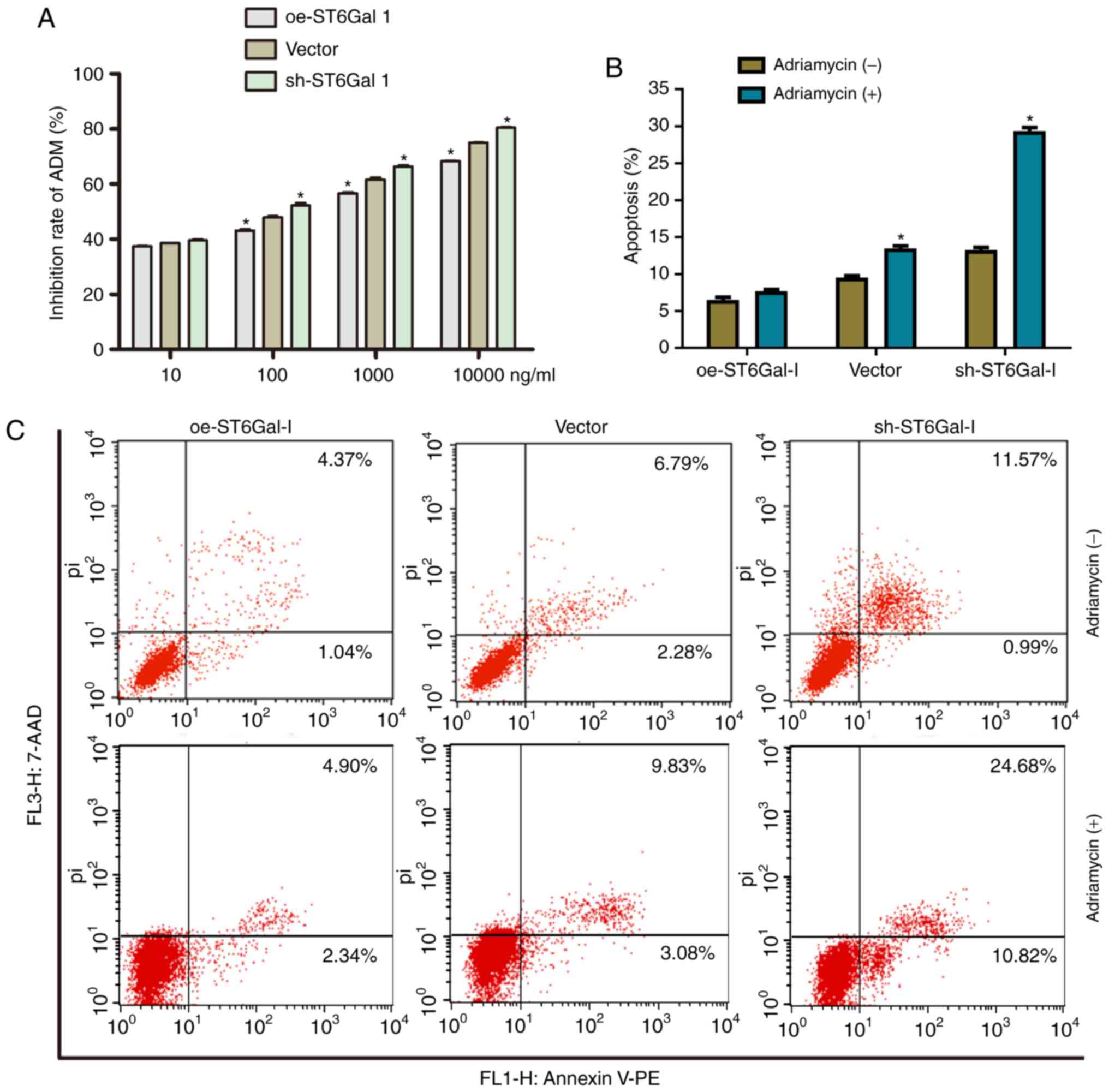|
1
|
Eswarakumar VP, Lax I and Schlessinger J:
Cellular signaling by fibroblast growth factor receptors. Cytokine
Growth Factor Rev. 16:139–149. 2005. View Article : Google Scholar : PubMed/NCBI
|
|
2
|
Cotton LM, O'Bryan MK and Hinton BT:
Cellular signaling by fibroblast growth factors (FGFs) and their
receptors (FGFRs) in male reproduction. Endocr Rev. 29:193–216.
2008. View Article : Google Scholar : PubMed/NCBI
|
|
3
|
Touat M, Ileana E, Postel-Vinay S, André F
and Soria JC: Targeting FGFR signaling in cancer. Clin Cancer Res.
21:2684–2694. 2015. View Article : Google Scholar : PubMed/NCBI
|
|
4
|
Manchado E, Weissmueller S, Morris JP IV,
Chen CC, Wullenkord R, Lujambio A, de Stanchina E, Poirier JT,
Gainor JF, Corcoran RB, et al: A combinatorial strategy for
treating KRAS-mutant lung cancer. Nature. 534:647–651. 2016.
View Article : Google Scholar : PubMed/NCBI
|
|
5
|
Turkington RC, Longley DB, Allen WL,
Stevenson L, McLaughlin K, Dunne PD, Blayney JK, Salto-Tellez M,
Van Schaeybroeck S and Johnston PG: Fibroblast growth factor
receptor 4 (FGFR4): A targetable regulator of drug resistance in
colorectal cancer. Cell Death Dis. 5:e10462014. View Article : Google Scholar : PubMed/NCBI
|
|
6
|
Ye T, Wei X, Yin T, Xia Y, Li D, Shao B,
Song X, He S, Luo M, Gao X, et al: Inhibition of FGFR signaling by
PD173074 improves antitumor immunity and impairs breast cancer
metastasis. Breast Cancer Res Treat. 143:435–446. 2014. View Article : Google Scholar : PubMed/NCBI
|
|
7
|
Wan X, Corn PG, Yang J, Palanisamy N,
Starbuck MW, Efstathiou E, Li Ning Tapia EM, Zurita AJ, Aparicio A,
Ravoori MK, et al: Prostate cancer cell-stromal cell crosstalk via
FGFR1 mediates antitumor activity of dovitinib in bone metastases.
Sci Transl Med. 6:252ra1222014. View Article : Google Scholar : PubMed/NCBI
|
|
8
|
Schweiger N, Hauck M, Steinhoff H, Sampl
S, Reifinger M, Walter I, Kreilmeier T, Marian B, Grusch M, Berger
W, et al: Canine and human sarcomas exhibit predominant FGFR1
expression and impaired viability after inhibition of signaling.
Mol Carcinog. 54:841–852. 2015. View
Article : Google Scholar : PubMed/NCBI
|
|
9
|
Garay T, Molnár E, Juhász É, László V,
Barbai T, Dobos J, Schelch K, Pirker C, Grusch M, Berger W, et al:
Sensitivity of melanoma cells to EGFR and FGFR activation but not
inhibition is influenced by oncogenic BRAF and NRAS mutations.
Pathol Oncol Res. 21:957–968. 2015. View Article : Google Scholar : PubMed/NCBI
|
|
10
|
Cole C, Lau S, Backen A, Clamp A, Rushton
G, Dive C, Hodgkinson C, McVey R, Kitchener H and Jayson GC:
Inhibition of FGFR2 and FGFR1 increases cisplatin sensitivity in
ovarian cancer. Cancer Biol Ther. 10:495–504. 2010. View Article : Google Scholar : PubMed/NCBI
|
|
11
|
Meng QH, Xu E, Hildebrandt MA, Liang D, Lu
K, Ye Y, Wagar EA and Wu X: Genetic variants in the fibroblast
growth factor pathway as potential markers of ovarian cancer risk,
therapeutic response, and clinical outcome. Clin Chem. 60:222–232.
2014. View Article : Google Scholar : PubMed/NCBI
|
|
12
|
Birrer MJ, Johnson ME, Hao K, Wong KK,
Park DC, Bell A, Welch WR, Berkowitz RS and Mok SC: Whole genome
oligonucleotide-based array comparative genomic hybridization
analysis identified fibroblast growth factor 1 as a prognostic
marker for advanced-stage serous ovarian adenocarcinomas. J Clin
Oncol. 25:2281–2287. 2007. View Article : Google Scholar : PubMed/NCBI
|
|
13
|
Ivan M and Matei D: Blockade of FGF
signaling: Therapeutic promise for ovarian cancer. Cancer Biol
Ther. 10:505–508. 2010. View Article : Google Scholar : PubMed/NCBI
|
|
14
|
Marmé F, Hielscher T, Hug S, Bondong S,
Zeillinger R, Castillo-Tong DC, Sehouli J, Braicu I, Vergote I,
Isabella C, et al: Fibroblast growth factor receptor 4 gene (FGFR4)
388Arg allele predicts prolonged survival and platinum sensitivity
in advanced ovarian cancer. Int J Cancer. 131:E586–E591. 2012.
View Article : Google Scholar : PubMed/NCBI
|
|
15
|
Zhao X, Zhou Y, Chen YU and Yu F: miR-494
inhibits ovarian cancer cell proliferation and promotes apoptosis
by targeting FGFR2. Oncol Lett. 11:4245–4251. 2016. View Article : Google Scholar : PubMed/NCBI
|
|
16
|
Zecchini S, Bombardelli L, Decio A,
Bianchi M, Mazzarol G, Sanguineti F, Aletti G, Maddaluno L, Berezin
V, Bock E, et al: The adhesion molecule NCAM promotes ovarian
cancer progression via FGFR signalling. EMBO Mol Med. 3:480–494.
2011. View Article : Google Scholar : PubMed/NCBI
|
|
17
|
Yang F, Zhang Y, Ressler SJ, Ittmann MM,
Ayala GE, Dang TD, Wang F and Rowley DR: FGFR1 is essential for
prostate cancer progression and metastasis. Cancer Res.
73:3716–3724. 2013. View Article : Google Scholar : PubMed/NCBI
|
|
18
|
Welm BE, Freeman KW, Chen M, Contreras A,
Spencer DM and Rosen JM: Inducible dimerization of FGFR1:
Development of a mouse model to analyze progressive transformation
of the mammary gland. J Cell Biol. 157:703–714. 2002. View Article : Google Scholar : PubMed/NCBI
|
|
19
|
Bohrer LR and Schwertfeger KL: Macrophages
promote fibroblast growth factor receptor-driven tumor cell
migration and invasion in a CXCR2-dependent manner. Mol Cancer Res.
10:1294–1305. 2012. View Article : Google Scholar : PubMed/NCBI
|
|
20
|
Duchesne L, Tissot B, Rudd TR, Dell A and
Fernig DG: N-glycosylation of fibroblast growth factor receptor 1
regulates ligand and heparan sulfate co-receptor binding. J Biol
Chem. 281:27178–27189. 2006. View Article : Google Scholar : PubMed/NCBI
|
|
21
|
Taniguchi N and Korekane H: Branched
N-glycans and their implications for cell adhesion, signaling and
clinical applications for cancer biomarkers and in therapeutics.
BMB Rep. 44:772–781. 2011. View Article : Google Scholar : PubMed/NCBI
|
|
22
|
Dall'Olio F, Malagolini N, Trinchera M and
Chiricolo M: Mechanisms of cancer-associated glycosylation changes.
Front Biosci (Landmark Ed). 17:670–699. 2012. View Article : Google Scholar : PubMed/NCBI
|
|
23
|
Schultz MJ, Swindall AF and Bellis SL:
Regulation of the metastatic cell phenotype by sialylated glycans.
Cancer Metastasis Rev. 31:501–518. 2012. View Article : Google Scholar : PubMed/NCBI
|
|
24
|
Dall'Olio F, Malagolini N, Trinchera M and
Chiricolo M: Sialosignaling: Sialyltransferases as engines of
self-fueling loops in cancer progression. Biochim Biophys Acta.
1840:2752–2764. 2014. View Article : Google Scholar : PubMed/NCBI
|
|
25
|
Harduin-Lepers A, Vallejo-Ruiz V,
Krzewinski-Recchi MA, Samyn-Petit B, Julien S and Delannoy P: The
human sialyltransferase family. Biochimie. 83:727–737. 2001.
View Article : Google Scholar : PubMed/NCBI
|
|
26
|
Lee M, Park JJ and Lee YS: Adhesion of
ST6Gal I-mediated human colon cancer cells to fibronectin
contributes to cell survival by integrin beta1-mediated paxillin
and AKT activation. Oncol Rep. 23:757–761. 2010.PubMed/NCBI
|
|
27
|
Swindall AF and Bellis SL: Sialylation of
the Fas death receptor by ST6Gal-I provides protection against
Fas-mediated apoptosis in colon carcinoma cells. J Biol Chem.
286:22982–22990. 2011. View Article : Google Scholar : PubMed/NCBI
|
|
28
|
Zhuo Y, Chammas R and Bellis SL:
Sialylation of beta1 integrins blocks cell adhesion to galectin-3
and protects cells against galectin-3-induced apoptosis. J Biol
Chem. 283:22177–22185. 2008. View Article : Google Scholar : PubMed/NCBI
|
|
29
|
Park JJ, Yi JY, Jin YB, Lee YJ, Lee JS,
Lee YS, Ko YG and Lee M: Sialylation of epidermal growth factor
receptor regulates receptor activity and chemosensitivity to
gefitinib in colon cancer cells. Biochem Pharmacol. 83:849–857.
2012. View Article : Google Scholar : PubMed/NCBI
|
|
30
|
Britain CM, Dorsett KA and Bellis SL: The
glycosyltransferase ST6Gal-I protects tumor cells against serum
growth factor withdrawal by enhancing survival signaling and
proliferative potential. J Biol Chem. 292:4663–4673. 2017.
View Article : Google Scholar : PubMed/NCBI
|
|
31
|
Livak KJ and Schmittgen TD: Analysis of
relative gene expression data using real-time quantitative PCR and
the 2(-Delta Delta C(T)) Method. Methods. 25:402–408. 2001.
View Article : Google Scholar : PubMed/NCBI
|
|
32
|
Saporiti F, Piacentini L, Alfieri V, Bono
E, Ferrari F, Chiesa M and Colombo GI: Melanocortin-1 receptor
positively regulates human artery endothelial cell migration. Cell
Physiol Biochem. 52:1339–1360. 2019. View Article : Google Scholar : PubMed/NCBI
|
|
33
|
Park JS, Lee JS, Kim EY, Jung JY, Kim SK,
Chang J, Kim DJ, Lee CY, Jung I and Kim JH: The frequency and
impact of FGFR1 amplification on clinical outcomes in Korean
patients with small cell lung cancer. Lung Cancer. 88:325–331.
2015. View Article : Google Scholar : PubMed/NCBI
|
|
34
|
Preusser M, Berghoff AS, Berger W,
Ilhan-Mutlu A, Dinhof C, Widhalm G, Dieckmann K, Wöhrer A, Hackl M,
von Deimling A, et al: High rate of FGFR1 amplifications in brain
metastases of squamous and non-squamous lung cancer. Lung Cancer.
83:83–89. 2014. View Article : Google Scholar : PubMed/NCBI
|
|
35
|
Gessi M, Moneim YA, Hammes J, Goschzik T,
Scholz M, Denkhaus D, Waha A and Pietsch T: FGFR1 mutations in
Rosette-forming glioneuronal tumors of the fourth ventricle. J
Neuropathol Exp Neurol. 73:580–584. 2014. View Article : Google Scholar : PubMed/NCBI
|
|
36
|
Wu J, Wei T, Tang Q, Weng B, Li W, Jiang
X, Ding T, Li X, Liang G, Cai Y and Ji J: Discovery and anti-cancer
evaluation of two novel non-ATP-competitive FGFR1 inhibitors in
non-small-cell lung cancer. BMC Cancer. 15:2762015. View Article : Google Scholar : PubMed/NCBI
|
|
37
|
Turner N and Grose R: Fibroblast growth
factor signalling: From development to cancer. Nat Rev Cancer.
10:116–129. 2010. View Article : Google Scholar : PubMed/NCBI
|
|
38
|
Mohammadi M, Froum S, Hamby JM, Schroeder
MC, Panek RL, Lu GH, Eliseenkova AV, Green D, Schlessinger J and
Hubbard SR: Crystal structure of an angiogenesis inhibitor bound to
the FGF receptor tyrosine kinase domain. EMBO J. 17:5896–5904.
1998. View Article : Google Scholar : PubMed/NCBI
|
|
39
|
Nguyen PT, Tsunematsu T, Yanagisawa S,
Kudo Y, Miyauchi M, Kamata N and Takata T: The FGFR1 inhibitor
PD173074 induces mesenchymal-epithelial transition through the
transcription factor AP-1. Br J Cancer. 109:2248–2258. 2013.
View Article : Google Scholar : PubMed/NCBI
|
|
40
|
Torre LA, Bray F, Siegel RL, Ferlay J,
Lortet-Tieulent J and Jemal A: Global cancer statistics, 2012. CA
Cancer J Clin. 65:87–108. 2015. View Article : Google Scholar : PubMed/NCBI
|
|
41
|
Lee M, Lee HJ, Bae S and Lee YS: Protein
sialylation by sialyltransferase involves radiation resistance. Mol
Cancer Res. 6:1316–1325. 2008. View Article : Google Scholar : PubMed/NCBI
|
|
42
|
Zhuo Y and Bellis SL: Emerging role of
alpha2,6-sialic acid as a negative regulator of galectin binding
and function. J Biol Chem. 286:5935–5941. 2011. View Article : Google Scholar : PubMed/NCBI
|
|
43
|
Gui T and Shen K: The epidermal growth
factor receptor as a therapeutic target in epithelial ovarian
cancer. Cancer Epidemiol. 36:490–496. 2012. View Article : Google Scholar : PubMed/NCBI
|
|
44
|
McKie AB, Vaughan S, Zanini E, Okon IS,
Louis L, de Sousa C, Greene MI, Wang Q, Agarwal R, Shaposhnikov D,
et al: The OPCML tumor suppressor functions as a cell surface
repressor-adaptor, negatively regulating receptor tyrosine kinases
in epithelial ovarian cancer. Cancer Discov. 2:156–171. 2012.
View Article : Google Scholar : PubMed/NCBI
|
|
45
|
Gorringe KL, Jacobs S, Thompson ER,
Sridhar A, Qiu W, Choong DY and Campbell IG: High-resolution single
nucleotide polymorphism array analysis of epithelial ovarian cancer
reveals numerous microdeletions and amplifications. Clin Cancer
Res. 13:4731–4739. 2007. View Article : Google Scholar : PubMed/NCBI
|
|
46
|
Whitworth MK, Backen AC, Clamp AR, Wilson
G, McVey R, Friedl A, Rapraeger AC, David G, McGown A, Slade RJ, et
al: Regulation of fibroblast growth factor-2 activity by human
ovarian cancer tumor endothelium. Clin Cancer Res. 11:4282–4288.
2005. View Article : Google Scholar : PubMed/NCBI
|
|
47
|
Chen X, Wang L, Zhao Y, Yuan S, Wu Q, Zhu
X, Niang B, Wang S and Zhang J: ST6Gal-I modulates docetaxel
sensitivity in human hepatocarcinoma cells via the p38 MAPK/caspase
pathway. Oncotarget. 7:51955–51964. 2016.PubMed/NCBI
|
|
48
|
Singleton KR, Hinz TK, Kleczko EK, Marek
LA, Kwak J, Harp T, Kim J, Tan AC and Heasley LE: Kinome RNAi
screens reveal synergistic targeting of MTOR and FGFR1 pathways for
treatment of lung cancer and HNSCC. Cancer Res. 75:4398–4406. 2015.
View Article : Google Scholar : PubMed/NCBI
|
|
49
|
Anderson HJ and Galileo DS: Small-molecule
inhibitors of FGFR, integrins and FAK selectively decrease
L1CAM-stimulated glioblastoma cell motility and proliferation. Cell
Oncol (Dordr). 39:229–242. 2016. View Article : Google Scholar : PubMed/NCBI
|
|
50
|
Wales CT, Taylor FR, Higa AT, McAllister
HA and Jacobs AT: ERK-dependent phosphorylation of HSF1 mediates
chemotherapeutic resistance to benzimidazole carbamates in
colorectal cancer cells. Anticancer Drugs. 26:657–666.
2015.PubMed/NCBI
|
|
51
|
Xiao Z, Ding N, Xiao G, Wang S, Wu Y and
Tang L: Reversal of multidrug resistance by gefitinib via RAF1/ERK
pathway in pancreatic cancer cell line. Anat Rec (Hoboken).
295:2122–2128. 2012. View Article : Google Scholar : PubMed/NCBI
|
|
52
|
Zhang J and Hochwald SN: The role of FAK
in tumor metabolism and therapy. Pharmacol Ther. 142:154–163. 2014.
View Article : Google Scholar : PubMed/NCBI
|
|
53
|
Lee BY, Timpson P, Horvath LG and Daly RJ:
FAK signaling in human cancer as a target for therapeutics.
Pharmacol Ther. 146:132–149. 2015. View Article : Google Scholar : PubMed/NCBI
|
|
54
|
Katoh M: FGFR inhibitors: Effects on
cancer cells, tumor microenvironment and whole-body homeostasis
(Review). Int J Mol Med. 38:3–15. 2016. View Article : Google Scholar : PubMed/NCBI
|















